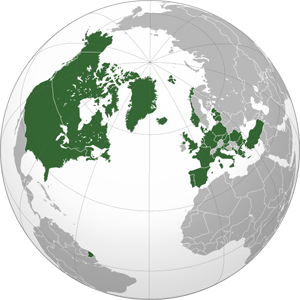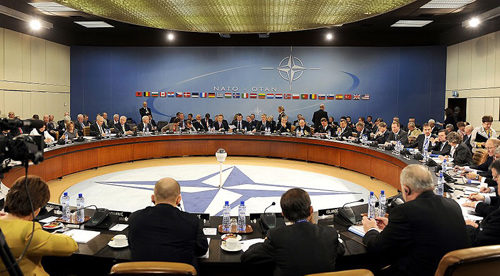Considering History: The Cold War, the Korean War, and the Development of NATO
This column by American studies professor Ben Railton explores the connections between America’s past and present.

The North Atlantic Treaty Organization (NATO) was formed in the aftermath of World War II, as an attempt to establish collective defenses against emerging Cold War threats from the Soviet Union and its allies. Five Northern European nations (Belgium, France, the Netherlands, Luxembourg, and the UK) began the process with the March 1948 Treaty of Brussels, and then brought their alliance to the United States and its Secretary of State George C. Marshall. With Marshall’s guidance those six nations, joined by Canada, Portugal, Italy, Norway, Denmark, and Iceland, signed the April 1949 North Atlantic Treaty, officially forming NATO.
Yet the Cold War of course extended far beyond the North Atlantic worlds, and NATO likewise was not limited to that sphere of influence. Indeed, it was in response to a Southeast Asian military conflict that began the following year, the Korean War, that NATO truly began to develop its international military forces and strategies, reflecting interconnections between these regions and issues that remain vital to this day.
While the Korean War’s background and origins were as complex and multi-faceted as any military conflict’s, the war began in earnest with North Korea’s June 25th, 1950 crossing of the 38th Parallel and invasion of South Korea. The United Nations Security Council unanimously condemned the invasion on the same day, and two days later President Truman ordered U.S. air and sea support for South Korean forces. By July 5th U.S. armed forces were on the ground and taking part in the Battle of Osan alongside South Korean troops, a military alliance that would continue for the remaining three years of the war.

While Truman and new Secretary of State Dean Acheson focused their initial public statements on the specific need to defend South Korea from the North’s aggressions, Truman very much believed that the war was part of larger Cold War conflicts as well. As he later argued in his memoir, Years of Trial and Hope (1956), “Communism was acting in Korea, just as Hitler, Mussolini and the Japanese had ten, fifteen, and twenty years earlier. I felt certain that if South Korea was allowed to fall, Communist leaders would be emboldened to override nations closer to our own shores. If the Communists were permitted to force their way into the Republic of Korea without opposition from the free world, no small nation would have the courage to resist threat and aggression by stronger Communist neighbors.”

NATO saw the Korean conflict and its ramifications in the same way, and responded accordingly. In September 1950 the NATO Military Committee called for a buildup of military forces to counter potential Soviet and allied aggressions around the world, and shortly thereafter the organization formed the Supreme Headquarters Allied Powers Europe (SHAPE), appointing Supreme Allied Commander Dwight D. Eisenhower as its first leader. These efforts culminated in the February 1952 North Atlantic Council meeting in Lisbon, at which a number of key steps were taken: the creation of a Long-Term Defence Plan; the proposed expansion of combat-ready forces to 96 divisions (reduced to 35 the following year, which was still a significant increase); and the creation of a new Secretary General position, with the UK’s Lord Ismay appointed as the first NATO Secretary General.
NATO followed these efforts by undertaking its first major maritime exercise, Exercise Mainbrace, in September 1952. Although Eisenhower had by then resigned his position to run for the presidency, two American military officers and NATO leaders coordinated the exercise: General Matthew B. Ridgway, who had succeeded Eisenhower as Supreme Allied Commander Europe after commanding all U.S. and United Nations troops in Korea from 1951 to 1952; and Admiral Lynde D. McCormick, the Supreme Allied Commander Atlantic and himself a veteran of World War II’s Pacific Theater. Under their lead, more than 200 ships and 80,000 men participated in twelve days of military exercises, what New York Times reporter Hanson Baldwin called “the largest and most powerful fleet that has cruised in the North Sea since World War I.”
The headline of Baldwin’s article linked the exercises to NATO’s “Important Role in Defense of Europe.” Yet the exercise’s timing, along with Ridgway’s Korean War experiences and other overt links, made clear just how much the ongoing conflict in Korea served as a vital context and inspiration for these early 1950s NATO buildups and plans. By the July 1953 final armistice that ended the Korean War, NATO had largely become the sizeable, vital international military and diplomatic organization it would remain for the Cold War’s subsequent decades, one that, while centered in the North Atlantic, reflects a world in which Russia, Southeast Asia, and every region and nation are interconnected in the era’s issues and conflicts.
